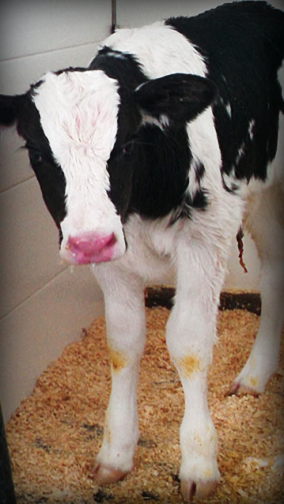The cow has successfully calved. You’ve brought her water, you moved the calf into her own clean pen, and then what? The answer should be…dip the newborn calf’s navel. Before birth, the umbilical cord was the calf’s lifeline to the dam. It allowed for the exchange of nutrients from cow to calf and the removal of waste from the calf to the cow for excretion. Once born, this nutrient highway is severed and becomes a direct route for bacterial pathogens if not properly disinfected.
Keeping it Clean
To best prevent infection and complications, dipping the umbilical stump in iodine is the simplest method with years of success behind it. Simply locate the navel stump and submerge it to completely and thoroughly coat it with a tincture of iodine. The iodine will help to disinfect the area and the alcohol within it will help to dry out the stump faster. If the area isn’t stained with that distinct burnt orange color, it is best to reapply. Consider dipping a second time 12 – 18 hours later for better overall protection. Double dipping is a definitely a good thing when it comes to umbilical care. Also, if the umbilical stump is longer than 6 inches, trimming it with clean shears may help to reduce complications.

Infection & Sepsis
As mentioned earlier, the newly severed umbilical cord is easy access for bacteria. If not properly disinfected a navel infection is likely, which can quickly lead to sepsis. Sepsis is the result of bacteria entering the blood stream. In this case, bacteria enter through the umbilical stump and travel directly into the circulating blood. Once in the blood, bacteria quickly spread throughout the calf’s body causing fever, liver abscesses, swollen joints, loss of appetite, depression, and eventually shock and death.
Other pathogens that can enter through the untreated umbilical stump are salmonella, E. coli, rotavirus, and cryptosporidium. All of these provide a health challenge to the calf, resulting in high treatment costs, and can reduced performance in calves that survive. Dipping navels is an easy and economical way to increase performance and decrease death loss.
Cost of Treatment
Treatment of sepsis calls for some heavy duty antibiotic treatments. Other than the cost of medications, care for these sick calves calls for extra labor for giving treatments, monitoring health, and overall care to get the calf back on track, which all has a price. What is worse is that the likelihood of these calves reaching their potential is unlikely. Their growth will be slowed and the stress on their system can sometimes lead to death months or even years after the initial infection.
Getting Iodine
The tried and true product for dipping navels has been iodine; however, due to its use in the production of methamphetamines, the DEA has changed the chemical listing of iodine from list 2 (commonly available) to list 1 (regulated). While veterinarians can still obtain iodine, other handlers of iodine are undergoing more strict guidelines for distribution and inspections by the DEA. Any tinctures above 2.2% fall under these regulations. Some alternatives to the 7% iodine that do not contain these restrictions would be Triodine 7 (contains level of iodine below DEA regulation limit), Navel-Guard (contains alcohol but no iodine), and Super 7+ Navel Dip (contains no iodine or alcohol).
Dipping navels is highly effective with little monetary investment. Few other things in a calf’s life will cost this little and provide such long term benefits.
Umbilical Uproar: Why Dipping Navels is Worth Your Time
Famo Feeds • 446 Industrial Dr • Freeport, MN • 800-450-2145

